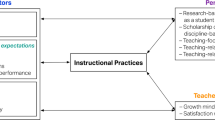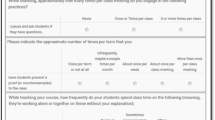Abstract
Prior studies have identified the impact beliefs have on mathematics instructors’ instructional practice, such as their choice to (or not to) lecture. However, the role of instructional context role in influencing beliefs and instruction has not been thoroughly researched. This paper explores how course context and beliefs could impact mathematics instructors’ propensity to lecture by investigating two very different instructional contexts in undergraduate mathematics in the United States: Calculus and Abstract Algebra. The results of our regression analyses were significant in both data sets and, we did find beliefs in each context that predicted the amount of time spent lecturing. For instance, the more calculus instructors believed in the effectiveness of teacher-centered instructional practices, the more likely they were to lecture. Whereas the more abstract algebra instructors believed in their student’s capacity to learn the less likely they were to lecture. However, while the regression model for the abstract algebra instructors accounted for 37.8% of the variability in the reported amount of time spent lecturing, the model for Calculus instructors only accounted for 2.7% of the variability. Thus our analyses indicate that there are contextual differences, such as course coordination, student demographics, and the job security of the instructors, that may be mitigating the extent to which beliefs impact instructional practice.
Similar content being viewed by others
Availability of Data and Materials
The CSPCC data that support the findings of this study are available from the Mathematical Association of America, but restrictions apply to the availability of these data, which were used under license for the current study, and so are not publicly available. Data from the AA survey are available from the authors upon reasonable request.
References
Allman, J., Hetherington III, N., Ksir, A., & Selbach-Allen, M. (2018). Coordinating IBL and non-IBL Calculus II. Mathematica Militaris, 23(1), 4.
Artemeva, N., & Fox, J. (2011). The writing’s on the board: The global and the local in teaching undergraduate mathematics through chalk talk. Written Communication, 28(4), 345–379.
Bressoud, D. (2015). The calculus student. In D. M. Bressoud, V. Mesa, & C. L. Rasmussen (Eds.), Insights and recommendations from the MAA national study of college calculus (pp. 1–16). Mathematical Association of America.
Bressoud, D. M., Mesa, V., & Rasmussen, C. L. (Eds.). (2015). Insights and recommendations from the MAA national study of college calculus. MAA Press.
Burn, H., & Mesa, V. (2015). The calculus I curriculum. In D. M. Bressoud, V. Mesa, & C. L. Rasmussen (Eds.), Insights and recommendations from the MAA national study of college calculus (pp. 45–57). Mathematical Association of America.
Burstein, L., McDonnell, L. M., van Winkle, J., Ormseth, T., Mirocha, J., & Guitton, G. (1995). Validating national curriculum indicators. Santa Monica, CA: RAND.
Cohen, J. (1998). Statistical power analysis for the behavioral sciences (2nd ed.). Erlbaum.
Cooney, T. J. (1985). A beginning teacher's view of problem solving. Journal for research in mathematics education, 324–336.
Freeman, S., Eddy, S. L., McDonough, M., Smith, M. K., Okoroafor, N., Jordt, H., & Wenderoth, M. P. (2014). Active learning increases student performance in science, engineering, and mathematics. Proceedings of the National Academy of Sciences, 111(23), 8410–8415.
Fukawa-Connelly, T., Johnson, E., & Keller, R. (2016). Can math education research improve the teaching of abstract algebra? Notices of the American Mathematical Society, 63.
Fukawa-Connelly, T., Weinberg, A., Wieser, E., Berube, S., & Gray, K. (2012). The implied observer of a mathematics lecture. Proceedings of the 15th annual conference on Research in Undergraduate Mathematics Education.
Galloway, C. (2001). Vygotsky’s Constructivism. In M. Orey (Ed.), Emerging perspectives on learning, teaching, and technology (pp. 48-49). Zurich, CH: Global Text Project.
Giannoulis, C. (n.d.). Life After Exploratory Factor Analysis: Estimating Internal Consistency. The Analysis Factor. Retrieved 3 Mar 2021, from https://www.theanalysisfactor.com/life-after-exploratory-factor-analysis/
Hagman, J. E., Johnson, E., & Fosdick, B. K. (2017). Factors contributing to students and instructors experiencing a lack of time in college calculus. International Journal of STEM Education, 4(12), 1-15.
Hayward, C. N., Kogan, M., & Laursen, S. L. (2016). Facilitating instructor adoption of inquiry-based learning in college mathematics. International Journal of Research in Undergraduate Mathematics Education, 2(1), 59–82. https://doi.org/10.1007/s40753-015-0021-y
Hayward, C., Weston, T., & Laursen, S. (2018). First results from a validation study of TAMI: Toolkit for Assessing Mathematics Instruction. In A. Weinberg, C. Rasmussen, J. Rabin, M. Wawro, & S. Brown (Eds.), Proceedings of the 21st Annual Conference on the Research in Undergraduate Mathematics Education (pp. 727–735). San Diego: Mathematical Association of America, SIGMAA on RUME.
Henderson, C., Beach, A., & Finkelstein, N. (2011). Facilitating change in undergraduate STEM instructional practices: An analytic review of the literature. Journal of research in science teaching, 48(8), 952–984.
Henderson, C, & Dancy, M. (2007). Barriers to the use of research-based instructional strategies: the influence of both individual and situational characteristics. Physical Review Special Topics - Physics Education Research, 3(2), 020102.
Henderson, C., & Dancy, M. H. (2009). Impact of physics education research on the teaching of introductory quantitative physics in the United States. Physical Review Special Topics-Physics Education Research, 5(2), 020107.
Hoadley, U. (2003). Time to learn: Pacing and the external framing of teachers’ work. Journal of Education for Teaching, 29(3), 265–277.
Hora, M. T. (2012). Organizational factors and instructional decision-making: a cognitive perspective. The Review of Higher Education, 35(2), 207–235. Johns Hopkins University Press.
Hoyles, C. (1992). Mathematics teaching and mathematics teachers: A meta-case study. For the Learning of Mathematics, 12(3), 32–44.
Ingram, P., & Clay, K. (2000). The choice-within-constraints new institutionalism and implications for sociology. Annual Review of Sociology, 26(1), 525–546. https://doi.org/10.1146/annurev.soc.26.1.525
Johnson, E. (2016). What is in Calculus I? MAA FOCUS, 36(2). 17-20.
Johnson, E. (2019). Chapter 6. Undergraduate mathematics instruction: Not as bad as you’d think? S. Laursen & B. Ruedi (Eds.), Levers for change: An assessment of progress on changing STEM instruction. American Association for the Advancement of Science. Washington, DC.
Johnson, E., Caughman, J., Fredericks, J., & Gibson, L. (2013). Implementing inquiry-oriented curriculum: From the mathematicians’ perspective. The Journal of Mathematical Behavior, 32(4), 743-760.
Johnson, E., Ellis, J., & Rasmussen, C. (2016) It's about time: the relationships between coverage and instructional practices in college calculus. International Journal of Mathematical Education in Science and Technology, 47(4), 491-504. https://doi.org/10.1080/0020739X.2015.1091516
Johnson, E., Keller, R., & Fukawa-Connelly, T. (2017). Results from a survey of Abstract Algebra instructors across the United States: Understanding the choice to (not) lecture. International Journal of Research in Undergraduate Mathematics Education, 1-32.
Johnson, E., Keller, R., Peterson, V., & Fukawa-Connelly, T. (2019). Individual and situational factors related to undergraduate mathematics instruction. International Journal of STEM Education, 6(1), 23.
Kaufman, J. H., Stein, M. K., & Junker, B. (2016). Factors associated with alignment between teacher survey reports and classroom observation ratings of mathematics instruction. The Elementary School Journal, 116(3), 339–364.
Keith, T. Z. (2015). Multiple regression and beyond: An introduction to multiple regression and structural equation modeling (2nd ed.). Routledge.
Kuster, G., Johnson, E., Keene, K., & Andrews-Larson, C. (2017). Inquiry-oriented instruction: A conceptualization of the instructional principles. PRIMUS, 28(1), 13–30.
Leatham, K. (2006). Viewing mathematics teachers’ beliefs as sensible systems. Journal of Mathematics Teacher Education, 9(1), 91–102. https://doi.org/10.1007/s10857-006-9006-8
Mayer, D. P. (1999). Measuring instructional practice: Can policymakers trust survey data? Educational Evaluation and Policy Analysis, 21(1), 29–45.
McDuffie, A. R., & Graeber, A. O. (2003). Institutional norms and policies that influence college mathematics professors in the process of changing to reform-based practices. School Science and Mathematics, 103(7), 331–344.
Mesa, V., Celis, S., & Lande, E. (2014). Teaching approaches of community college mathematics faculty: Do they relate to classroom practices? American Educational Research Journal, 51(1), 117–151.
Oleson, A., & Hora, M. T. (2014). Teaching the way they were taught? Revisiting the sources of teaching knowledge and the role of prior experience in shaping faculty teaching practices. Higher Education, 68(1), 29–45.
Pajares, M. F. (1992). Teachers’ beliefs and educational research: cleaning up a messy construct. Review of Educational Research, 62(3), 307–332. https://doi.org/10.3102/00346543062003307
Philipp, R. A. (2007). Mathematics teachers’ beliefs and affect. Second handbook of research on mathematics teaching and learning, 1, 257-315.
President’s Council of Advisors on Science and Technology (PCAST). (2012). Engage to excel: Producing one million additional college graduates with Degrees in Science, Technology, Engineering, and Mathematics. Washington, DC: The White House.
Rasmussen, C., & Ellis, J. (2015). Calculus coordination at PhD-granting universities: More than just using the same syllabus, textbook, and final exam. In Bressoud, D. M., Mesa, V., & Rasmussen, C. L. (Eds.), Insights and recommendations from the MAA national study of college calculus. Washington, DC: Mathematical Association of America.
Remillard, J. T. (2005). Examining key concepts in research on teachers’ use of mathematics curricula. Review of Educational Research, 75(2), 211–246.
Ross, J. A., McDougall, D., & Hogaboam-Gray, A. (2003). A survey measuring elementary teachers’ implementation of standards-based mathematics teaching. Journal for Research in Mathematics Education, 34(4), 344–363.
Saxe, K., & Braddy, L. (2015). A common vision for undergraduate mathematical sciences programs in 2025. Mathematical Association of America.
Selinski, N. E., & Milbourne, H. (2015). The impact of instructor and institutional factors on students’ attitudes. In Bressoud, D. M., Mesa, V., & Rasmussen, C. L. (Eds.), Insights and recommendations from the MAA national study of college calculus. Washington, DC: Mathematical Association of America.
Seymour, E., & Hewitt, N. M. (1997). Talking about leaving: Why undergraduates leave the Sciences. Westview Press.
Seymour, E., & Hunter, A.B. (2019). Talking about leaving revisited: persistence, relocation, and loss in undergraduate STEM education.
Smith, M. K., Vinson, E. L., Smith, J. A., Lewin, J. D., & Stetzer, M. R. (2014). A campus-wide study of STEM courses: new perspectives on teaching practices and perceptions. CBE- Life Sciences Education, 13(4), 624–635.
Speer, N. (2005). Issues of methods and theory in the study of mathematics teachers’ professed and attributed beliefs. Educational Studies in Mathematics, 58(3), 361–391. https://doi.org/10.1007/s10649-005-2745-0
Speer, N. M. (2008). Connecting beliefs and practices: A fine-grained analysis of a college mathematics teacher’s collections of beliefs and their relationship to his instructional practices. Cognition and Instruction, 26(2), 218–267.
Vygotsky, L. (1978). Mind in society: The development of higher psychological processes (M. Cole, V. John-Steiner, S. Scribner, & E. Souberman, Eds.). Cambridge, MA: Harvard University Press.
Weber, K. (2004). Traditional instruction in advanced mathematics courses: A case study of one professor’s lectures and proofs in an introductory real analysis course. The Journal of Mathematical Behavior, 23(2), 115–133.
Funding
The CSPCC elements of this paper are supported by the National Science Foundation, award #DRL-0910240. Any opinions and findings expressed in this material are of the authors’ and do not necessarily reflect the views of NSF.
Author information
Authors and Affiliations
Corresponding author
Ethics declarations
Conflicts of Interest
The authors declare they do not have conflicts of interest.
Additional information
Publisher's Note
Springer Nature remains neutral with regard to jurisdictional claims in published maps and institutional affiliations.
Appendix
Appendix
Plot of standardized predicted values against standardized residuals for the CSPCC data (Left) and AA data (right). For the CSPCC data, the Loess line of best fit suggests linearity was not a reasonable assumption while the spread of the data suggests homoscedasticity was met. For the AA data, the Loess line of best fit suggests linearity was a reasonable assumption while the spread of the data suggests homoscedasticity was not met
Rights and permissions
About this article
Cite this article
Chowdhury, A.H., Mullins, S.B. & Johnson, E. Context Matters: Understanding the Relationship Between Instructor’s Beliefs and the Amount of Time Spent Lecturing. Int. J. Res. Undergrad. Math. Ed. 8, 550–580 (2022). https://doi.org/10.1007/s40753-021-00158-5
Accepted:
Published:
Issue Date:
DOI: https://doi.org/10.1007/s40753-021-00158-5








